Characteristics of Chemical Accidents and Risk Assessment Method for Petrochemical Enterprises Based on Improved FBN
Abstract
:1. Introduction
2. Statistical Characteristics of Chemical Accidents
2.1. Sources of Accident and Index Data
2.2. Accident Analysis
2.3. Analysis of Overall Characteristics of Accidents
2.4. Category Analysis of Accident
3. Risk Analysis Method
3.1. Bayesian Network
3.1.1. Prior Probability
- (1)
- Quantitative statistical method
- (2)
- Analytic Hierarchy Process (AHP)
- (3)
- Combination weight
3.1.2. Conditional Probability
3.1.3. Importance Analysis of Root Node
3.1.4. Posterior Probability of Root Node
4. Case Study
4.1. Basic Steps of Enterprise Risk Analysis
4.2. Risk Identification Enterprise
4.2.1. Production Process Analysis of Enterprise
4.2.2. Identification of Enterprise Risk Sources
4.3. Topology and Parameter Construction of Bayesian Network
- (1)
- Prior probability
- (2)
- Conditional probability
- (3)
- Posterior probability
4.4. Sensitivity Analysis
4.5. Coupling Risk Analysis
5. Conclusions
- (1)
- Petrochemical accidents in China were generally decreasing; leakage, fire and explosion were the main types of accidents; safety risk research for petrochemical enterprises had a a positive impact on enterprise risk control; and, in future enterprise safety risk research, more attention should be paid to the study of leakage, fire and explosion accident risk sources.
- (2)
- According to the critical importance analysis of enterprise risk factors, the results indicated that improper operation, insufficient safety awareness, improper supervision, the risk of the production safety responsibility system and inadequate emergency management were the most critical root events of the enterprise, and human factors were the most important influencing factors of all factors.
- (3)
- In the production of enterprises, coupling risk has a relatively large impact on enterprise security. Enterprises should strictly control the superposition of multiple risk factors in the production process.
Author Contributions
Funding
Institutional Review Board Statement
Informed Consent Statement
Data Availability Statement
Conflicts of Interest
References
- Zhou, K.; Xiao, L.; Lin, Y.; Yuan, D.; Wang, J. A Statistical Analysis of Hazardous Chemical Fatalities (HCFs) in China between 2015 and 2021. Sustainability 2022, 14, 2435. [Google Scholar] [CrossRef]
- Liu, X.; Li, J.; Li, X. Study of dynamic risk management system for flammable and explosive dangerous chemicals storage area. J. Loss Prev. Process Ind. 2017, 49, 983–988. [Google Scholar] [CrossRef]
- Wang, B.; Wu, C.; Reniers, G.; Huang, L.; Kang, L.; Zhang, L. The future of hazardous chemical safety in China: Opportunities, problems, challenges and tasks. Sci. Total Environ. 2018, 643, 1–11. [Google Scholar] [CrossRef] [PubMed]
- Wang, B.; Li, D.; Wu, C. Characteristics of hazardous chemical accidents during hot season in China from 1989 to 2019: A statistical investigation. Saf. Sci. 2020, 129, 104788. [Google Scholar] [CrossRef]
- Wang, J.; Fu, G.; Yan, M. Comparative analysis of two catastrophic hazardous chemical accidents in China. Process Saf. Prog. 2020, 39. [Google Scholar] [CrossRef]
- Zhang, N.; Shen, S.L.; Zhou, A.N.; Chen, J. A brief report on the March 21, 2019 explosions at a chemical factory in Xiangshui, China. Process Saf. Prog. 2019, 38, e12060. [Google Scholar] [CrossRef]
- Al-Samhan, M.; Al-Fadhli, J.; Al-Otaibi, A.M.; Al-Attar, F.; Bouresli, R.; Rana, M.S. Prospects of refinery switching from conventional to integrated: An opportunity for sustainable investment in the petrochemical industry. Fuel 2022, 310, 122161. [Google Scholar] [CrossRef]
- Zeng, T.; Chen, G.; Yang, Y.; Reniers, G.; Zhao, Y.; Liu, X. A Systematic Literature Review on Safety Research Related to Chemical Industrial Parks. Sustainability 2020, 12, 5753. [Google Scholar] [CrossRef]
- He, Z.; Weng, W. Synergistic effects on the physical effects of explosions in multi-hazard coupling accidents in chemical industries. J. Loss Prev. Process Ind. 2022, 77, 104800. [Google Scholar] [CrossRef]
- Masalegooyan, Z.; Piadeh, F.; Behzadian, K. A comprehensive framework for risk probability assessment of landfill fire incidents using fuzzy fault tree analysis. Process Saf. Environ. Prot. 2022, 163, 679–693. [Google Scholar] [CrossRef]
- Tanaka, H.; Fan, L.T.; Lai, F.S.; Toguchi, K. Fault-Tree Analysis by Fuzzy Probability. IEEB 1983, 5, 453–457. [Google Scholar] [CrossRef]
- Bobbio, A.; Portinalea, L.; Minichinob, M.; Ciancamerla, E. Improving the analysis of dependable systems by mapping fault trees into Bayesian networks. Reliab. Eng. Syst. Saf. 2001, 71, 249–260. [Google Scholar] [CrossRef]
- Li, L.; Xu, K.; Yao, X.; Chen, S. Probabilistic analysis of aluminium production explosion accidents based on a fuzzy Bayesian network. J. Loss Prev. Process Ind. 2021, 73, 104618. [Google Scholar] [CrossRef]
- Li, S.; You, M.; Li, D.; Liu, J. Identifying coal mine safety production risk factors by employing text mining and Bayesian network techniques. Process Saf. Environ. Prot. 2022, 162, 1067–1081. [Google Scholar] [CrossRef]
- Cui, X.; Zhang, M.; Pan, W. Dynamic probability analysis on accident chain of atmospheric tank farm based on Bayesian network. Process Saf. Environ. Prot. 2022, 158, 146–158. [Google Scholar] [CrossRef]
- Yin, B.; Li, B.; Liu, G.; Wang, Z.; Sun, B. Quantitative risk analysis of offshore well blowout using bayesian network. Saf. Sci. 2021, 135, 105080. [Google Scholar] [CrossRef]
- Li, M.; Wang, H.; Wang, D.; Shao, Z.; He, S. Risk assessment of gas explosion in coal mines based on fuzzy AHP and bayesian network. Process Saf. Environ. Prot. 2020, 135, 207–218. [Google Scholar] [CrossRef]
- Ma, L.; Ma, X.; Xing, P.; Yu, F. A hybrid approach based on the HFACS-FBN for identifying and analysing human factors for fire and explosion accidents in the laboratory. J. Loss Prev. Process Ind. 2022, 75, 104675. [Google Scholar] [CrossRef]
- Qiao, W.; Liu, Y.; Ma, X.; Liu, Y. Human Factors Analysis for Maritime Accidents Based on a Dynamic Fuzzy Bayesian Network. Risk Anal. 2020, 40, 957–980. [Google Scholar] [CrossRef]
- Yazdi, M.; Kabir, S. A fuzzy Bayesian network approach for risk analysis in process industries. Process Saf. Environ. Prot. 2017, 111, 507–519. [Google Scholar] [CrossRef]
- Dueñas Santana, J.A.; Orozco, J.L.; Furka, D.; Furka, S.; Boza Matos, Y.C.; Febles Lantigua, D.; González Miranda, A.; Barrera González, M.C. A new Fuzzy-Bayesian approach for the determination of failure probability due to thermal radiation in domino effect accidents. Eng. Fail. Anal. 2021, 120, 105106. [Google Scholar] [CrossRef]
- Lu, Y.; Wang, T.; Liu, T. Bayesian Network-Based Risk Analysis of Chemical Plant Explosion Accidents. Int. J. Environ. Res. Public Health 2020, 17, 5364. [Google Scholar] [CrossRef] [PubMed]
- Standardization Administration of China. GB/T 13861-2022; Classification and Code of Hazardous and Harmful Factors in Production Process. Available online: https://openstd.samr.gov.cn/bzgk/gb/newGbInfo?hcno=BCBA1F97621C11B4B5A6C10783C93DB1 (accessed on 18 September 2022).
- Deng, F.; Gu, W.; Zeng, W.; Zhang, Z.; Wang, F. Hazardous Chemical Accident Prevention Based on K-Means Clustering Analysis of Incident Information. IEEE Access 2020, 8, 180171–180183. [Google Scholar] [CrossRef]
- Liu, J.-Y.; Leng, J.-Q.; Shang, P.; Luo, L.-J. Analysis of traffic crashes and injury severity influence factors for ice-snow covered freeway roads. J. Harbin Inst. Technol. 2022, 54, 57–64. [Google Scholar]
- Hoscan, O.; Cetinyokus, S. Determination of emergency assembly point for industrial accidents with AHP analysis. J. Loss Prev. Process Ind. 2021, 69, 104386. [Google Scholar] [CrossRef]
- Jianxing, Y.; Shibo, W.; Yang, Y.; Haicheng, C.; Haizhao, F.; Jiahao, L.; Shenwei, G. Process system failure evaluation method based on a Noisy-OR gate intuitionistic fuzzy Bayesian network in an uncertain environment. Process Saf. Environ. Prot. 2021, 150, 281–297. [Google Scholar] [CrossRef]
- Guo, X.; Ji, J.; Khan, F.; Ding, L.; Yang, Y. Fuzzy Bayesian network based on an improved similarity aggregation method for risk assessment of storage tank accident. Process Saf. Environ. Prot. 2021, 149, 817–830. [Google Scholar] [CrossRef]
- Liu, K.; Zong, S.; Wang, J.-X.; Pu, S.-X.; Wang, X. Collision risk analysis method of deepwater general FPSO based on fuzzy fault tree and Bayesian network. J. Ship Mech. 2022, 26, 574–583. [Google Scholar]
- Tabandeh, A.; Jia, G.; Gardoni, P. A review and assessment of importance sampling methods for reliability analysis. Struct. Saf. 2022, 97, 102216. [Google Scholar] [CrossRef]
- Zheng, Y.-B.; Shen, G.-X.; Zhang, Y.-Z.; Mu, L.-M.; Qin, M.-M. Importance analysis of chain-type tool magazine system based on Bayesian network. J. Jilin Univ. Eng. Technol. Ed. 2019, 49, 466–471. [Google Scholar]
- Ghasemi, F.; Gholamizadeh, K.; Farjadnia, A.; Sedighizadeh, A.; Kalatpour, O. Human and organizational failures analysis in process industries using FBN-HFACS model: Learning from a toxic gas leakage accident. J. Loss Prev. Process Ind. 2022, 78, 104823. [Google Scholar] [CrossRef]
- Wang, L.-F.; Xiao, Z.-W.; Yu, S.-S. New risk analysis method based on Bayesian network for hanging basker system of multi-tower cable-stayed bridge. J. Jilin Univ. Eng. Technol. Ed. 2022, 52, 865–873. [Google Scholar]
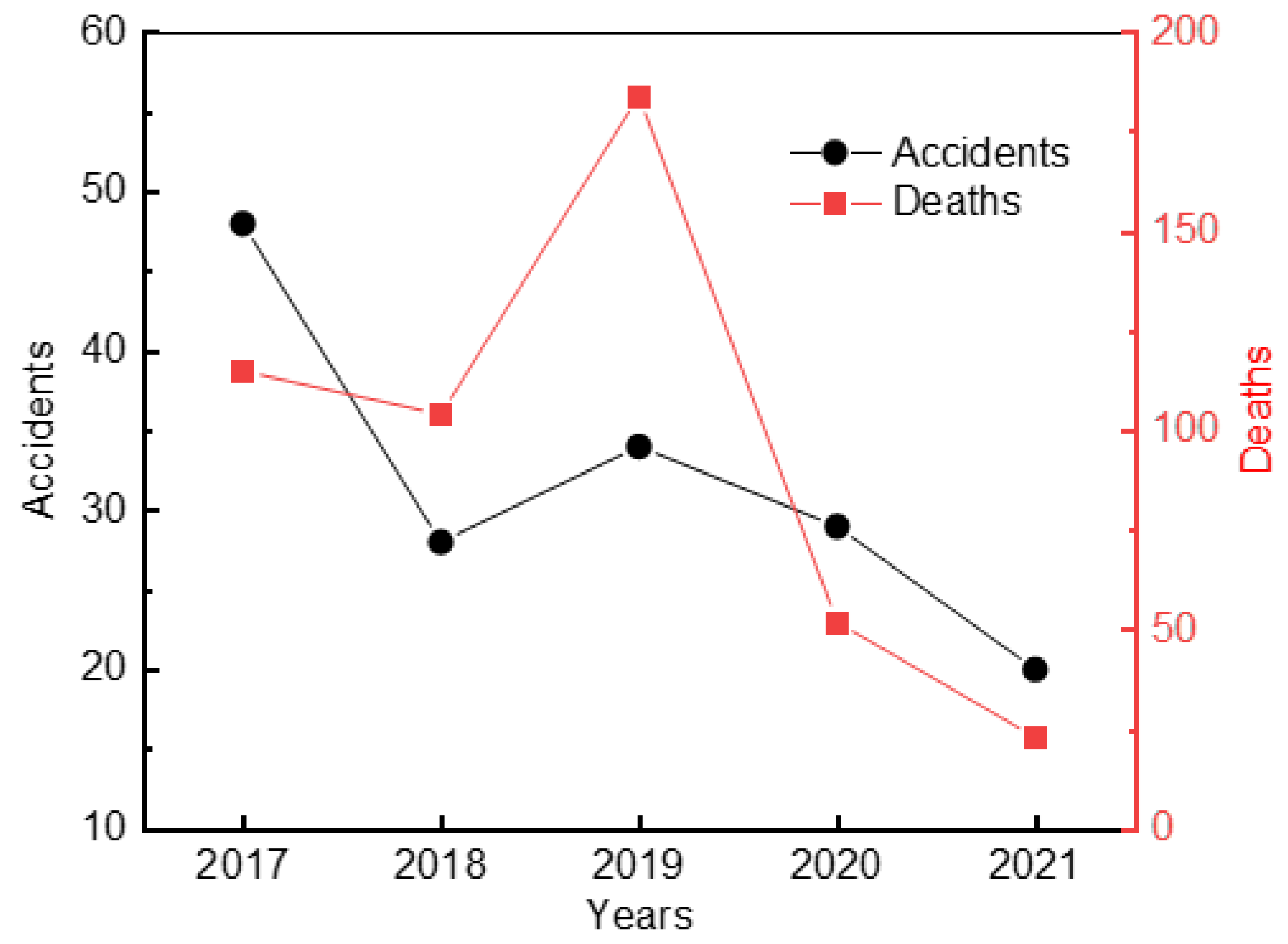
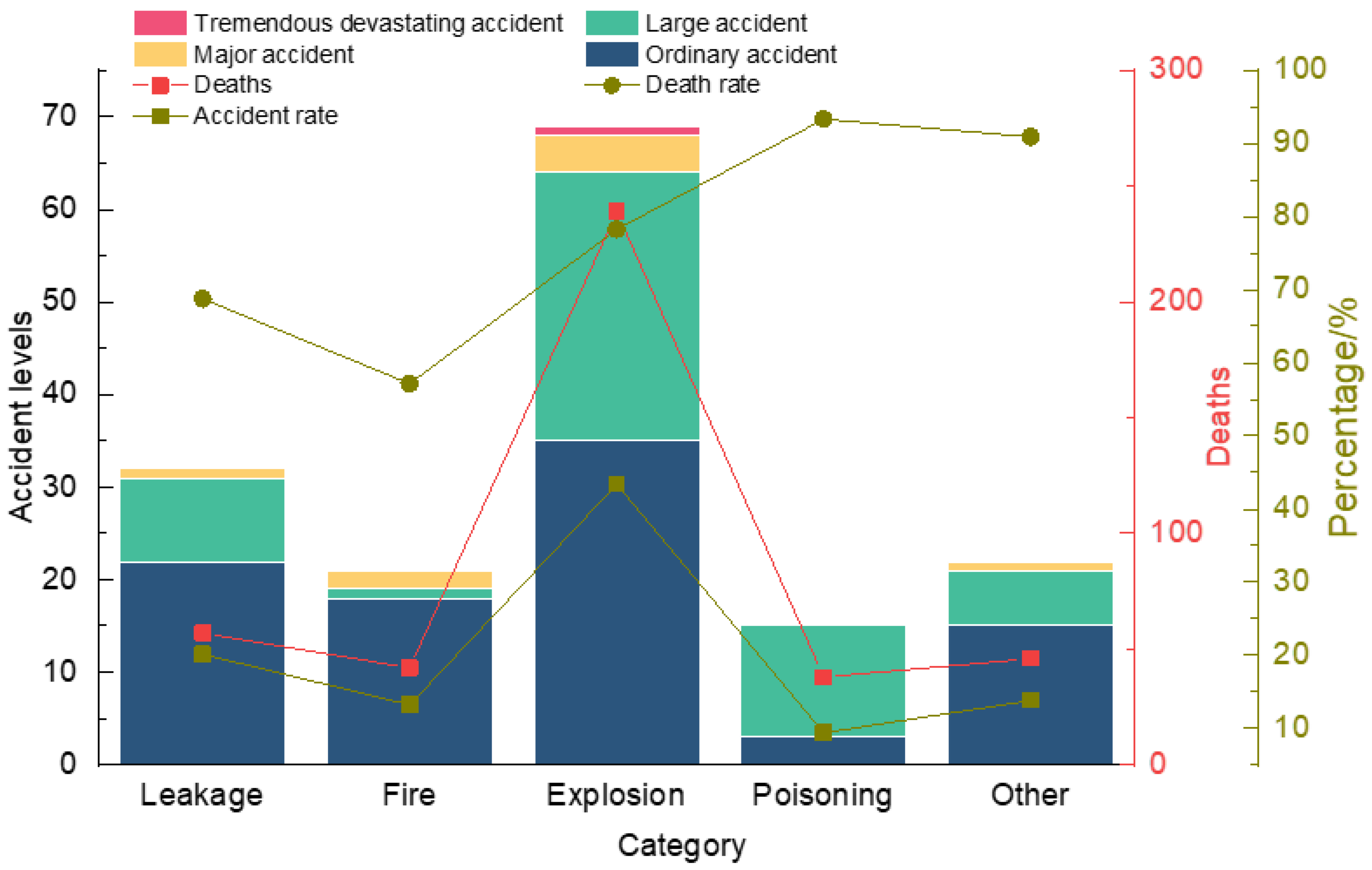



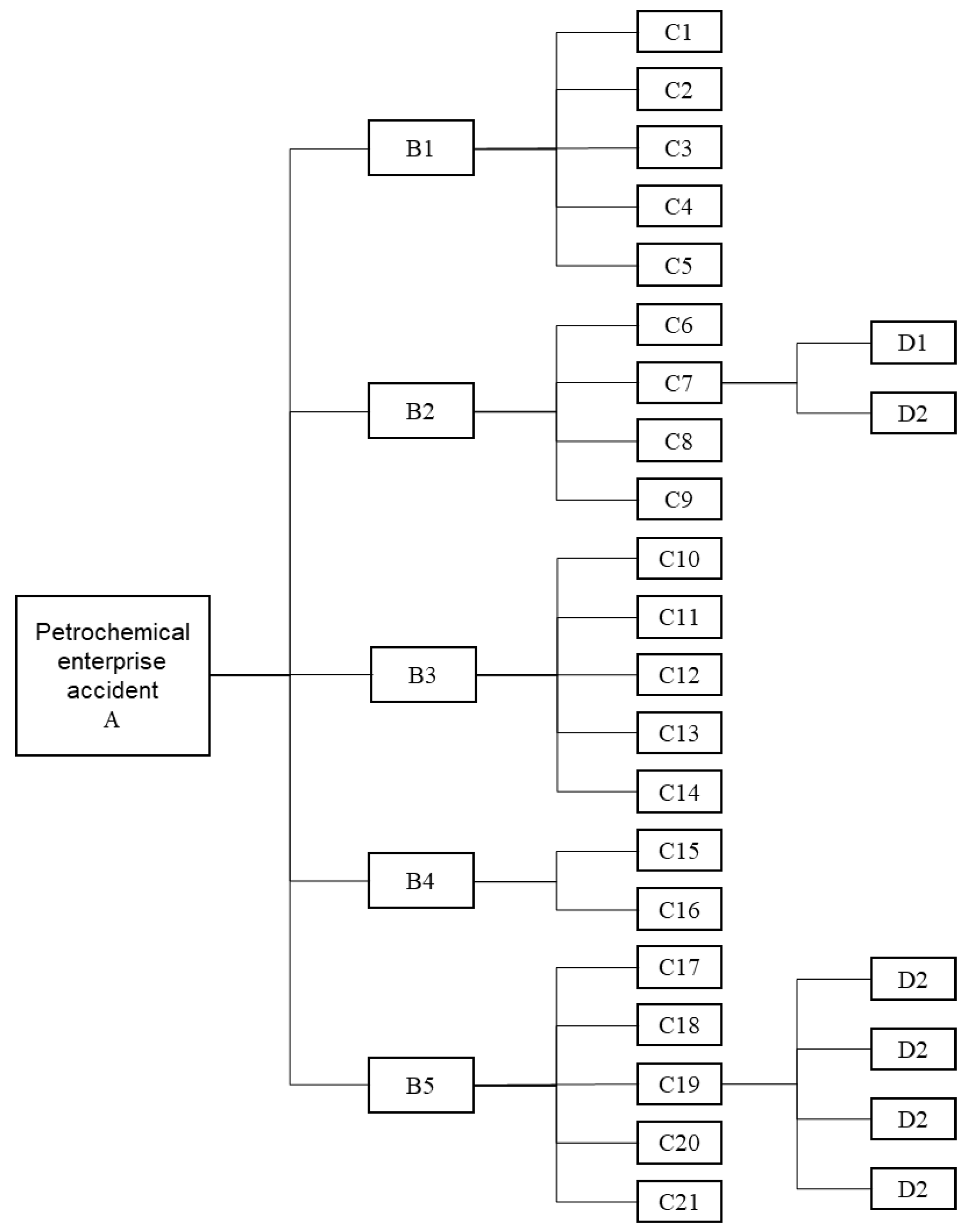
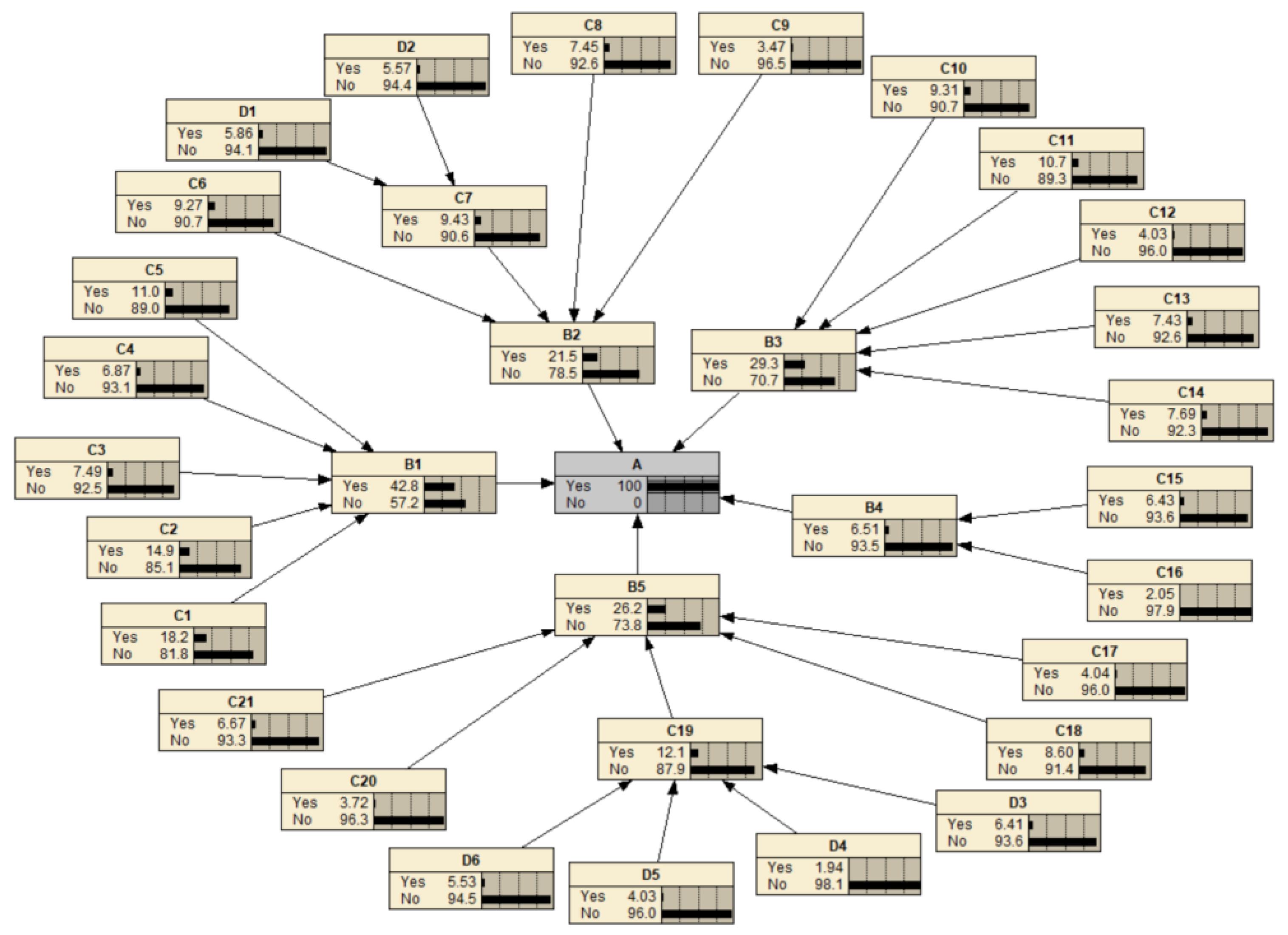
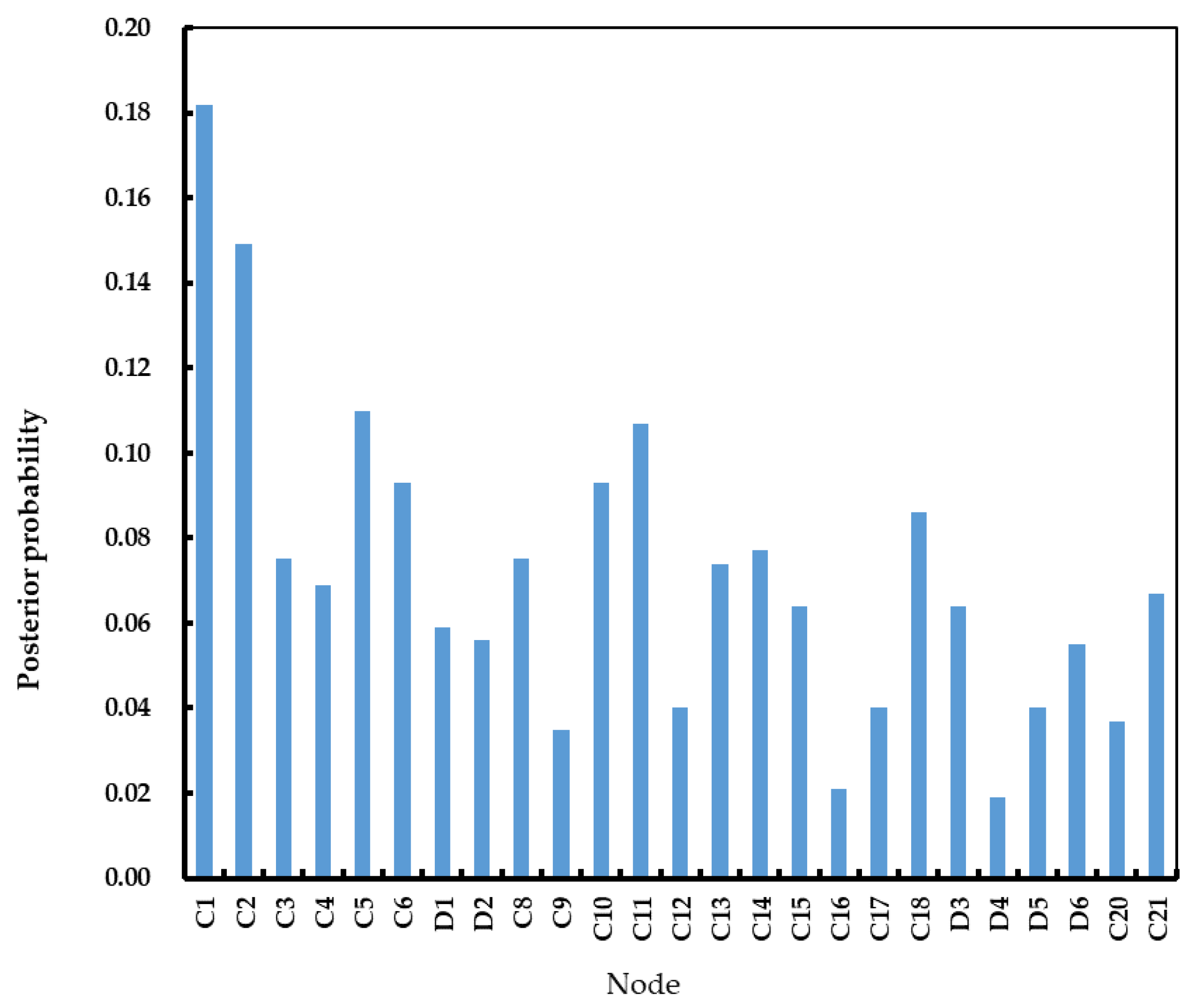
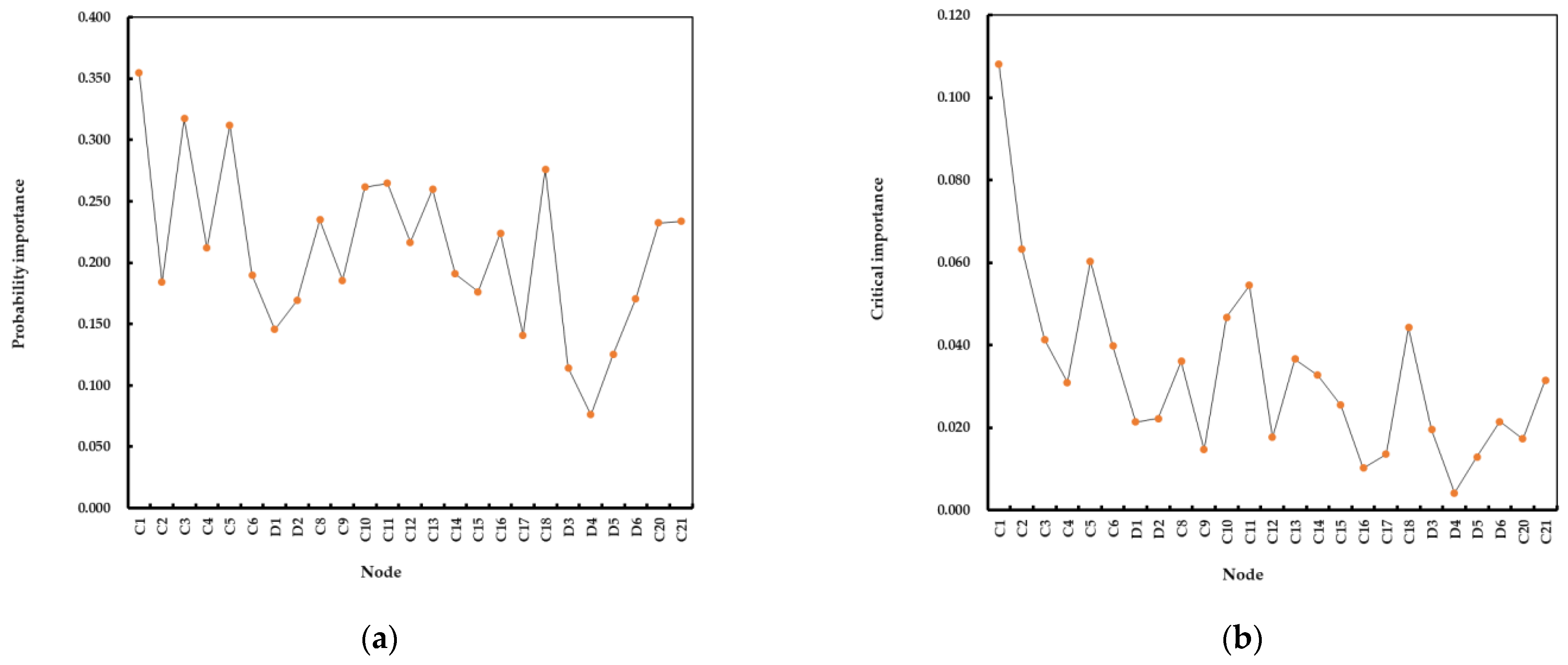

| Expert | |
|---|---|
| Senior engineer (E1) | 0.3 |
| Associate professor (E2) | 0.25 |
| Lecturer (E3) | 0.2 |
| Corporate security officer (E4) | 0.25 |
| Linguistic Term | Triangular Fuzzy Number |
|---|---|
| Very low (VL) | (0,0,0.25) |
| Low (L) | (0,0.25,0.5) |
| Medium (M) | (0.25,0.5,0.75) |
| High (H) | (0.75,1,1) |
| Very high (VH) | (0.75,1,1) |
| Level A | Level B | Level C | Level D | |||
|---|---|---|---|---|---|---|
| Leaf node A | B1 | Human factors | C1 | Improper operation | ||
| C2 | Insufficient security awareness | |||||
| C3 | Inadequate personnel qualifications | |||||
| C4 | Improper command | |||||
| C5 | Improper supervision | |||||
| B2 | Physical factors | C6 | Risk of toxic and hazardous substances | |||
| C7 | Defective equipment | D1 | Equipment design risk | |||
| D2 | Equipment quality risk | |||||
| C8 | Inadequate equipment safety maintenance | |||||
| C9 | Equipment automation situation | |||||
| B3 | Technical factors | C10 | Inadequate identification of production process risk | |||
| C11 | Imperfect safety operation procedures | |||||
| C12 | Inadequate technical briefing | |||||
| C13 | Risk of waste material disposal | |||||
| C14 | Inadequate risk classification and control | |||||
| B4 | Environmental factors | C15 | Operating environment risk | |||
| C16 | Natural environment risk | |||||
| B5 | Management factors | C17 | Organization and personnel organization | |||
| C18 | Risk of production safety responsibility system | |||||
| C19 | Risk of production safety management system | D3 | Safety education and training situation | |||
| D4 | Inadequate firework management | |||||
| D5 | Inadequate management of licensed work | |||||
| D6 | Risk of hidden danger investigation and management system | |||||
| C20 | Insufficient safety investment | |||||
| C21 | Inadequate emergency management | |||||
| Risk Category B | Risk Indicator C | Risk Indicator D | Root Node Subjective Weights |
|---|---|---|---|
| B1 (0.3718) | C1 (0.2437) | 0.0906 | |
| C2 (0.3444) | 0.1280 | ||
| C3 (0.0965) | 0.0359 | ||
| C4 (0.1577) | 0.0586 | ||
| C5 (0.1577) | 0.0586 | ||
| B2 (0.1875) | C6 (0/4673) | 0.0876 | |
| C7 (0.2772) | D1 (0.5000) | 0.0260 | |
| D2 (0.5000) | 0.0260 | ||
| C8 (0.1601) | 0.0300 | ||
| C9 (0.0954) | 0.0179 | ||
| B3 (0.2487) | C10 (0.2441) | 0.0607 | |
| C11 (0.2441) | 0.0607 | ||
| C12 (0.1221) | 0.0304 | ||
| C13 (0.2441) | 0.0607 | ||
| C14 (0.1456) | 0.0362 | ||
| B4 (0.0728) | C15 (0.7500) | 0.0546 | |
| C16 (0.2500) | 0.0182 | ||
| (0.1192) | C17 (0.1107) | 0.0132 | |
| C18 (0.1741) | 0.0208 | ||
| C19 (0.3080) | D3 (0.4673) | 0.0172 | |
| D4 (0.1601) | 0.0059 | ||
| D5 (0.0954) | 0.0035 | ||
| D6 (0.2772) | 0.0102 | ||
| C20 (0.0963) | 0.0115 | ||
| C21 (0.3108) | 0.0371 |
| Risk Category | Risk Factor | Frequency | Proportion |
|---|---|---|---|
| Human factors | Improper operation | 93 | 58.18% |
| Insufficient security awareness | 70 | 44.03% | |
| Inadequate personnel qualifications | 43 | 26.73% | |
| Improper command | 25 | 15.72% | |
| Improper supervision | 58 | 36.48% | |
| Physical factors | Risk of toxic and hazardous substances | 30 | 18.87% |
| Equipment quality risk | 55 | 34.59% | |
| Inadequate equipment safety maintenance | 65 | 40.88% | |
| Equipment automation situation | 30 | 18.87% | |
| Equipment design risk | 65 | 40.88% | |
| Technical factors | Inadequate identification of production process risk | 45 | 28.30% |
| Inadequate safety operation procedures | 63 | 39.31% | |
| Inadequate technical briefing | 18 | 11.01% | |
| Risk of waste material disposal | 20 | 12.58% | |
| Inadequate risk classification and control | 70 | 44.03% | |
| Environmental factors | Operating environment risk | 30 | 18.87% |
| Natural environment risk | 6 | 3.77% | |
| Management factors | Inadequate organization of institutions and personnel | 50 | 31.45% |
| Inadequate safety education and training | 93 | 58.18% | |
| Inadequate emergency management | 45 | 28.30% | |
| Risk of hidden danger investigation and management system | 73 | 45.60% | |
| Inadequate firework management | 30 | 18.87% | |
| Risk of production safety responsibility system | 83 | 51.89% | |
| Inadequate management of licensed work | 65 | 40.88% | |
| Inadequate safety investment | 36 | 22.64% |
| Root Node | Subjective Weight | Objective Weight | Combination Weight |
|---|---|---|---|
| Improper operation C1 | 0.0906 | 0.0738 | 0.082 |
| Insufficient safety awareness C2 | 0.1280 | 0.0555 | 0.092 |
| Insufficient personnel qualification C3 | 0.0359 | 0.0341 | 0.035 |
| Improper command C4 | 0.0586 | 0.0198 | 0.039 |
| Improper supervision C5 | 0.0586 | 0.0460 | 0.052 |
| Risk of toxic and hazardous substances C6 | 0.0876 | 0.0238 | 0.056 |
| Equipment design risk D1 | 0.0260 | 0.0515 | 0.039 |
| Equipment quality risk D2 | 0.0260 | 0.0436 | 0.035 |
| Inadequate equipment safety maintenance C8 | 0.0300 | 0.0515 | 0.041 |
| Equipment automation situation C9 | 0.0179 | 0.0238 | 0.021 |
| Inadequate identification of production process risk C10 | 0.0607 | 0.0357 | 0.048 |
| Safety operation procedures are not perfect C11 | 0.0607 | 0.0500 | 0.055 |
| Inadequate technical briefing C12 | 0.0304 | 0.0143 | 0.022 |
| Risk of waste material disposal C13 | 0.0607 | 0.0159 | 0.038 |
| Inadequate risk classification and control C14 | 0.0362 | 0.0555 | 0.046 |
| Operating environment risk C15 | 0.0546 | 0.0238 | 0.039 |
| Natural environment risk C16 | 0.0182 | 0.0048 | 0.012 |
| Organization and personnel C17 | 0.0132 | 0.0397 | 0.026 |
| Risk of production safety responsibility system C18 | 0.0208 | 0.0658 | 0.043 |
| Safety education and training D3 | 0.0172 | 0.0738 | 0.046 |
| Inadequate firework management D4 | 0.0059 | 0.0238 | 0.015 |
| Inadequate management of licensed work D5 | 0.0035 | 0.0515 | 0.028 |
| Risk of hidden danger investigation and management system D6 | 0.0102 | 0.0579 | 0.034 |
| Inadequate safety investment C20 | 0.0115 | 0.0285 | 0.020 |
| Inadequate emergency management C21 | 0.0371 | 0.0357 | 0.36 |
| Expert Judgment | |||||||
|---|---|---|---|---|---|---|---|
| B4C15 | L | H | H | H | |||
| B4C16 | H | H | L | H | |||
| Converting natural language with weights for expert evaluation into fuzzy numbers | |||||||
| B4C15 | (0.35, 0.60, 0.85) | ||||||
| B4C16 | (0.49, 0.65, 0.90) | ||||||
| Calculation of FPS using the average area method | |||||||
| P (B4C15) = 0.60 | P (B4C16) = 0.65 | ||||||
| Calculation of CPT using the noise-OR gate model | |||||||
| C15 | C16 | P (B4 = 1|C15, C16) | P (B4 = 0|C15, C16) | ||||
| 0 | 0 | 0 | 1 | ||||
| 1 | 0 | 0.60 | 0.40 | ||||
| 0 | 1 | 0.65 | 0.35 | ||||
| 1 | 1 | *0.86 | 0.14 | ||||
Publisher’s Note: MDPI stays neutral with regard to jurisdictional claims in published maps and institutional affiliations. |
© 2022 by the authors. Licensee MDPI, Basel, Switzerland. This article is an open access article distributed under the terms and conditions of the Creative Commons Attribution (CC BY) license (https://creativecommons.org/licenses/by/4.0/).
Share and Cite
Pan, L.; Zheng, Y.; Zheng, J.; Xu, B.; Liu, G.; Wang, M.; Yang, D. Characteristics of Chemical Accidents and Risk Assessment Method for Petrochemical Enterprises Based on Improved FBN. Sustainability 2022, 14, 12072. https://doi.org/10.3390/su141912072
Pan L, Zheng Y, Zheng J, Xu B, Liu G, Wang M, Yang D. Characteristics of Chemical Accidents and Risk Assessment Method for Petrochemical Enterprises Based on Improved FBN. Sustainability. 2022; 14(19):12072. https://doi.org/10.3390/su141912072
Chicago/Turabian StylePan, Lidong, Yu Zheng, Juan Zheng, Bin Xu, Guangzhe Liu, Min Wang, and Dingding Yang. 2022. "Characteristics of Chemical Accidents and Risk Assessment Method for Petrochemical Enterprises Based on Improved FBN" Sustainability 14, no. 19: 12072. https://doi.org/10.3390/su141912072





